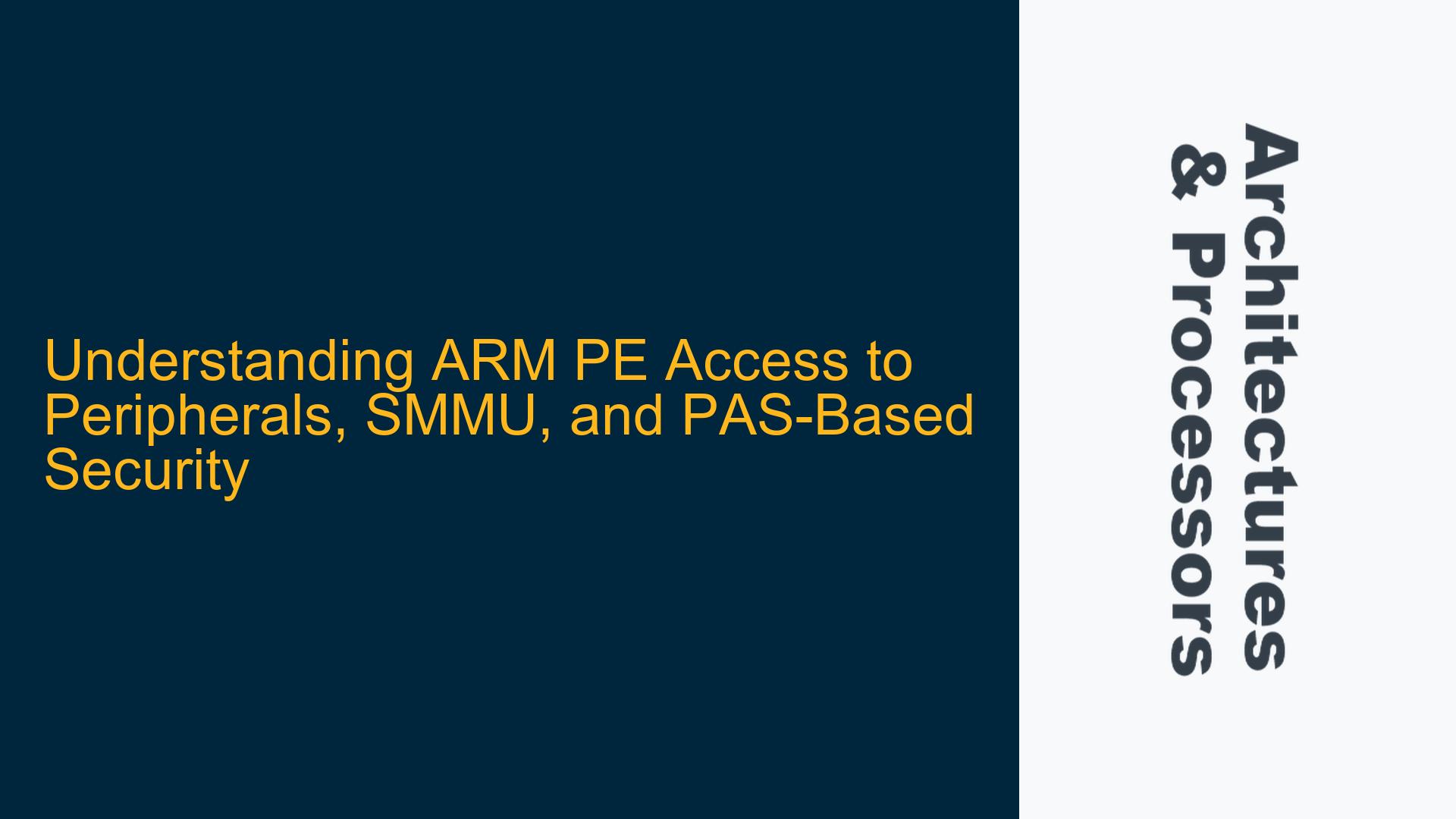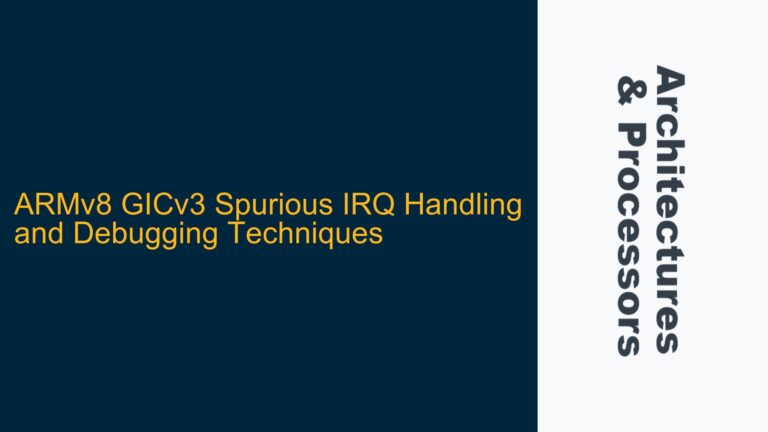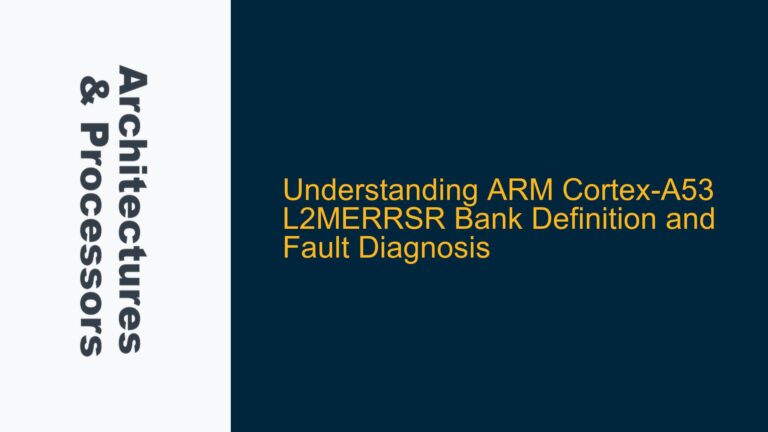ARM PE Access to Peripherals and Memory-Mapped Devices
In ARM-based systems, the Processing Element (PE) accesses peripherals and memory-mapped devices through a combination of memory-mapped I/O (MMIO) and system interconnects. The PE uses load (LDR) and store (STR) instructions to interact with peripheral registers and memory regions, treating them as if they were regular memory locations. However, the underlying hardware architecture determines how these transactions are routed and managed.
Peripherals in ARM systems are typically connected to the PE via a bus interface, such as AXI (Advanced eXtensible Interface). These peripherals expose their control and status registers through MMIO, where each register is assigned a unique physical address in the system’s address space. When the PE executes a load or store instruction targeting one of these addresses, the transaction is routed through the system interconnect to the appropriate peripheral.
The System Memory Management Unit (SMMU) plays a critical role in managing access to peripherals and memory regions, particularly in systems with multiple security domains or virtualization. The SMMU translates virtual addresses to physical addresses and enforces access permissions, similar to how the Memory Management Unit (MMU) operates for regular memory. However, not all peripheral accesses go through the SMMU. Devices connected to a non-coherent interconnect, such as certain on-chip peripherals, may bypass the SMMU entirely.
For example, a frame buffer used by a display controller is typically mapped to a specific physical address range. The PE can access this frame buffer using standard memory access instructions, with the transactions routed directly to the peripheral without SMMU involvement. In contrast, a GPU or other accelerator that generates memory requests as a bus master may route its transactions through the SMMU to ensure proper address translation and access control.
The distinction between "on-chip devices" and "peripherals" is also important. On-chip devices, such as GPUs or DMA controllers, are often capable of initiating memory transactions and may require SMMU translation for their requests. Peripherals, such as timers or UARTs, are typically accessed via MMIO and do not initiate transactions themselves. However, some devices, like the Generic Interrupt Controller (GIC), can function as both a peripheral (for configuration registers) and a device (for accessing memory-based interrupt tables).
SMMU, GPT, and PAS-Based Access Control
The SMMU and Granule Protection Table (GPT) are key components in enforcing access control and security in ARM systems. The SMMU translates virtual addresses to physical addresses for devices that initiate memory transactions, while the GPT enforces access permissions based on the Physical Address Space (PAS) associated with each transaction.
The PAS is a security attribute that identifies the origin or context of a memory transaction. For example, in a system with TrustZone security extensions, transactions may be tagged with a Secure or Non-Secure PAS. The GPT uses this information to determine whether a transaction is allowed to access a specific memory region or peripheral register.
When the PE accesses a peripheral register, the transaction includes the PAS of the requester. The peripheral or device may use this PAS to enforce additional access restrictions. For instance, the GIC uses the PAS to filter access to interrupt configuration registers. A Non-Secure transaction may only be allowed to access Non-Secure interrupt registers, while a Secure transaction can access both Secure and Non-Secure registers.
The GPT is configured by system software to define access permissions for different regions of the physical address space. Each GPT entry specifies which PAS values are allowed to access the corresponding memory region. For example, a GPT entry covering the GIC’s MMIO registers might permit all PAS values, allowing both Secure and Non-Secure transactions to access the registers. However, the GIC internally uses the PAS to enforce finer-grained access control, ensuring that Non-Secure transactions cannot modify Secure interrupt configurations.
This two-level access control mechanism provides flexibility and security. The GPT ensures that only authorized PAS values can access specific memory regions, while the peripheral or device enforces additional restrictions based on the transaction’s PAS. This approach is particularly useful in systems with multiple security domains or virtualization, where different software contexts may have varying levels of access to hardware resources.
Troubleshooting Peripheral Access and SMMU Configuration Issues
When troubleshooting issues related to peripheral access and SMMU configuration in ARM systems, it is essential to consider the following steps:
-
Verify Address Mapping and MMIO Configuration: Ensure that the peripheral’s MMIO registers are correctly mapped to the system’s physical address space. Check the device tree or platform configuration files to confirm that the base address and register offsets are accurate. Use a debugger or memory inspection tool to verify that the PE can read and write the peripheral registers as expected.
-
Check SMMU and GPT Configuration: If the peripheral access involves the SMMU, verify that the SMMU is properly configured for address translation and access control. Ensure that the SMMU’s translation tables are correctly populated and that the GPT entries for the peripheral’s address range permit the required PAS values. Use the SMMU’s debug registers to inspect the translation process and identify any errors.
-
Validate PAS-Based Access Control: For peripherals that enforce PAS-based access restrictions, such as the GIC, confirm that the transaction’s PAS matches the expected security context. Use a debugger to inspect the PAS value associated with the transaction and verify that the peripheral’s access control logic is functioning correctly. If access is denied, check the GPT configuration and the peripheral’s internal access control settings.
-
Inspect System Interconnect and Bus Transactions: Use a bus analyzer or system trace tool to capture and analyze the transactions between the PE and the peripheral. Look for any errors or unexpected behavior in the transaction flow, such as incorrect address decoding or access permissions. Verify that the transactions are routed through the correct path (e.g., SMMU or non-coherent interconnect) and that the peripheral responds as expected.
-
Review Peripheral-Specific Configuration: Some peripherals, such as the GIC, have complex configuration requirements that may impact access control. Review the peripheral’s documentation to ensure that all necessary configuration steps have been completed. For example, the GIC requires the interrupt groups and security settings to be configured before it can enforce PAS-based access restrictions.
By following these steps, you can systematically identify and resolve issues related to peripheral access and SMMU configuration in ARM systems. Understanding the interaction between the PE, SMMU, GPT, and peripherals is key to ensuring reliable and secure operation in complex embedded systems.






